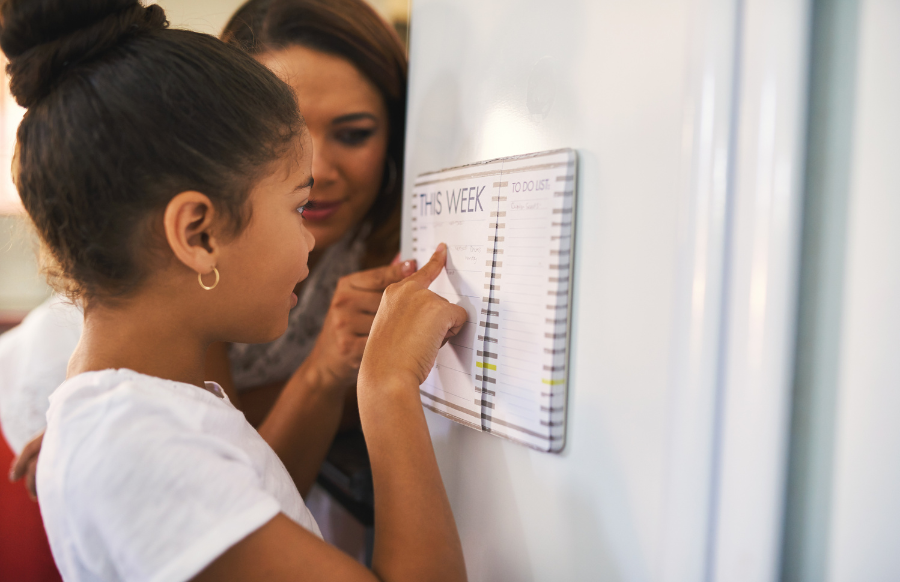Key Takeaways:
- List all household chores to start a fair division of labor. Delegation can be based on a complete list of tasks, from cooking and vacuuming to gutter cleaning.
- Based on abilities and interests, assign chores. Chores can be assigned based on age, skill level, and claims to encourage engagement and efficiency.
- To ensure smooth operations, discuss each task’s requirements and expected quality. Training and guidance for unfamiliar tasks boost confidence and effectiveness.
- Create and review a flexible chore schedule: A chart can help you remember your duties. This system should be flexible and regularly reassessed to accommodate family schedules, abilities, and interests.
Tired of shouldering the lion’s share of the housework while others in the family enjoy their downtime?
You’re not alone.
Recent studies show that many parents feel they have too much to do at home, which can lead to stress and anger. It doesn’t have to be like this, though.
Learning how to divide up the domestic tasks in your family makes your life easier and helps everyone feel more responsible and work better as a team. So how do you make a system that is fair and works well for everyone?
In this guide, we’ll show you how to give out household chores and make your home a place where everyone helps out.
Get ready for your household jobs to go from something you do alone to something the whole family does together.
Here’s a practical guide on how to divide chores in the family:

Identify and List Chores
Before dividing household duties, you need to know what must be done. The first step is to make a list of all the household duties. This may seem like an easy task, but it needs to be remembered. You might be surprised by how long this list is when you look at the details.
Make a list of everything that must be done to keep your home running smoothly, from vacuuming and laundry to grocery shopping and lawn care. Remember to add jobs you do less often, like cleaning the gutters or washing the windows.
By writing down the domestic chores, you can see how much work there is and use that as a reference point when dividing the duties. By identifying the important things, everyone in the family can better understand how much work needs to be done. It’s the first step toward dividing up household responsibilities fairly and effectively.
Assess Abilities and Interests

After you’ve made a complete list of all the household tasks, it’s time to think about skills and interests. Only some household members will be good at the same chores. Consider age, skills, and personal preferences when assigning domestic duties.
For example, young children can be given house chores like cleaning their rooms or helping set the table. Teenagers and older children, on the other hand, can do more complex tasks on their own, like mopping floors or making a simple meal.
Adults might take on chores that require more strength or a specific set of skills. But it’s also essential to think about what each person wants. Maybe your husband is really into gardening, or your teen wants to learn how to cook. Assigning chores related to their interests can make the process fun and motivate them.
By carefully looking at skills and interests, you can assign chores in the most effective and fun way, which makes it more likely that they will be done on time and without complaints. Remember that tasks don’t have to be work. They can also be ways to learn, grow, and even have fun.
Discuss Expectations

After making a list of household chores and figuring out the child’s skills and interests, setting the stage for a talk about expectations is essential. To avoid misunderstandings and ensure everyone is on the same page, it’s necessary to talk to each other.
Talk about what each task involves, how often it needs to be done, and what a good job looks like. For example, if the study is to “clean the kitchen,” does that include washing dishes, wiping down counters, sweeping the floor, and taking out the trash?
Mention the time frames as well. When do the dishes need to be done? How late can you leave your laundry folded? These rules can keep people from putting things off and help the household run smoothly.
Remember that this should be a family talk. Encourage everyone to say what they think and how they feel. This isn’t just about giving out jobs; it’s also about encouraging a sense of shared responsibility and teamwork. Clear expectations are set by ensuring everyone knows their duties and what they need to do to do them.
Assign Responsibilities

Now that you have a complete list of chores, an idea of what each family member is good at and interested in, and clear expectations, it’s time to assign household chores.
Think about what you’ve said so far. Who can do each duty the best? Who seemed to want to do specific tasks? By dividing up the work to match skills and interests, you can make the process more exciting and get more done.
Include everyone in the decision-making process when you give out chores. This will make them feel like they own and care about their tasks. It also encourages fairness because everyone gets a say in their duties.
Remember, consider how old and robust each family member is. It’s essential to ensure that the tasks given to each person are right for them. If you give someone a more complex task, they might get frustrated, and if you give them too easy, they might get bored.
Once chores are given out, ensuring everyone knows what to do is essential. When things aren’t clear, things can fall through the cracks. Your home will run like a well-oiled machine if everyone knows what to do.
Create a Chore Schedule or Chart

A chore chart or schedule helps manage tasks. It reminds everyone of their responsibilities and when to do them.
Start by choosing a format that works. This could be a paper list on the fridge, a digital schedule on each person’s device, or even a chore-management app. The key is to choose a method that is easy for everyone in the family to use and understand.
Then, write down the chores for each day or week, considering how often each needs to be done. During the week, family members might take turns doing the dishes or feeding the pets. Less frequent tasks, like washing windows and window screens, could be given out once a month.
Leave some room in your agenda for things that might come up or changes in your routine. Life can be hard to plan for, so your chart should be flexible.
Having a timetable or chart helps everyone stay on track and makes it less likely that chores will be forgotten or ignored. Plus, crossing something off your list feels good when you finish it.
Provide Training and Guidance

Training and directing them is essential once you’ve given people jobs and made a schedule. If a family member has never done a task before, expecting them to do it well without showing them how is unfair.
Start by showing them how to do the task. If it’s washing the plates, offer them how to scrub and rinse properly and, if you have a dishwasher, how to load it. If it’s laundry, show them how to sort it, set the washer upright, and use detergent safely.
Next, let them try doing the task while you watch and give them tips. This is a critical way to learn. It’s where most of the learning takes place.
Also, try to be patient and helpful. Remember that the goal isn’t just to get the chores done; it’s also to teach skills and responsibility. They might have to try a few times before they get it right. Your direction will give them the confidence they need to do their jobs well.
Encourage Collaboration

Everyone in the family should have tasks, but getting people to work together is also good. When people work together on missions, they call them done faster, get closer, and feel more like a team.
For example, everyone can help clean up after dinner. Someone can wash the dishes while someone else dries and puts away the plates. The table can be cleared, and the counters can be wiped down by someone else.
Collaboration also allows people to help each other out when things are busy or complicated. For example, if one person in the household has a hectic week coming up, the rest of the family can pitch in and help with their chores.
Encouraging people to work together ensures the household runs smoothly and helps create a supportive, cooperative family environment. It shows that you are all in this together and must work together to keep your home clean and in order.
Establish Deadlines or Time Frames

Setting deadlines or time frames for chores is crucial to managing the household workload and staying organized. Without a plan, assignments can pile up, causing stress and making the house look messy.
Deadlines should be reasonable, and consider all family members’ schedules. If your child has a lot of homework, you might not want to ask them to vacuum the whole house on a weekday night. Also, it might only be possible to demand that some chores be done first thing in the morning.
A well-thought-out schedule also considers how the chores need to be done. Some jobs, like doing the laundry or mowing the lawn, take longer and may need more time to finish.
By giving everyone clear deadlines, everyone knows when their work needs to be done. It helps everyone take accountability and ensures that chores are done on time. Just remember to keep an open mind. After all, things happen in life, and sometimes you have to make changes.
Regularly Evaluate and Adjust

Your system for dividing household chores should be evaluated and changed often, just like any other system. People’s interests, skills, and schedules can change over time, so the method for doing household chores should change too.
Your child might be interested in cooking for the first time and want to help make dinner a few nights a week. Or your partner’s work schedule has changed, and they can now do the grocery shopping.
Check-in with your family occasionally to see how the chore system is going for them. Are they happy with what they have to do? Is there something they wish they could change? Are the tasks being done in the time frame that was agreed upon?
If something doesn’t work, be willing to try something different. The goal is to develop a system that works for everyone and helps keep the house running smoothly. The key to keeping such a system going is to evaluate it often and be flexible.
Provide Appreciation and Recognition
Maureen Lezama is a mother of three boys and has a degree in Psychology. She shares, “Even before my kids complete their chores, I already begin saying words of praise and appreciation. Kids need to know their efforts are being appreciated, and it encourages the repetition of the behavior.”

Last but not least, showing appreciation for the work is essential. After all, doing chores around the house isn’t always the most fun thing; recognizing effort can go a long way toward keeping things happy.
Simple words of thanks can be more powerful than you think. A sincere “thank you” or “good job” can make people feel better and give them more drive. It shows that you see and appreciate the work they do to help out around the house.
If you want to take it further, you could set up a reward system, especially for younger children. This could be anything from more time to play to a special treat to let them stay up later. Rewarding someone shouldn’t take the place of telling them you appreciate them, but it can add another layer of motivation.
Remember that recognizing someone is not about making them compete with each other but about showing gratitude and reinforcing good behavior. By letting people know you appreciate them, you create a home where everyone feels valued and wants to help.
Final Thoughts

Having everyone in the family do their share of housework doesn’t just clean and organize your home. It teaches responsibility, teamwork, and goal-setting. Learning about each person’s skills and preferences, setting up a transparent and flexible chore system, and encouraging gratitude can make mundane tasks meaningful.
Remember, it’s not about perfection but about making a system everyone can use. Household chores can become a shared journey to a happy, healthy home with patience, cooperation, and a little planning.
Consider how your family divides housework today. It could bring unexpected benefits, new appreciation, and a happy, proud home. Plan chores joyfully!
Reference:
American Psychological Association: The impact of parental burnout; https://www.apa.org/monitor/2021/10/cover-parental-burnout

